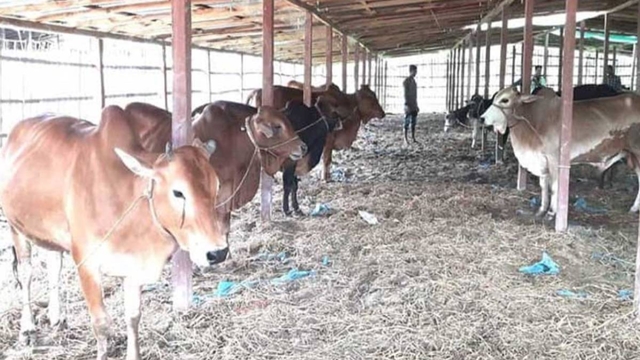FT Online
Published:2019-09-09 20:33:56 BdST
Youths make miracle in Bangladesh’s cattle sector
The youth is said to be the driving force behind the development of any country. This is also true in Bangladesh’s case. The country has been witnessing surplus production of cattle over the last three consecutive years, thanks to farmers, particularly the educated youths, for making a miracle in the sector.
According to statistics provided by the Department of Livestock Services (DLS), a total of 1,06,14,280 cattle, including 57,11,434 cows and buffalos, were slaughtered during the Eid-ul-Azha celebrated in Bangladesh on August 12 while the country had a stock of 1, 17, 88, 563 cattle.
“We’ve around 11, 74, 283 lakh surplus cattle this year. Hope, it’ll continue to rise as the number of cattle farm is increasing day by day,” said Dr ABM Khaleduzzaman, assistant director (farms) of DLS.
He said the highest number of 25, 53,774 cattle, including 14, 35, 614 cows and buffalos, were slaughtered during the eid in Dhaka division while the lowest 4, 93, 905 in Sylhet division.
At that time, the DLS officials said, the Chattogram division had the highest number of 1.35 lakh surplus cattle while the lowest 20,000 in Barisal division.
Khaleduzzaman said the availability of local cattle started increasing in Bangladesh since 2017 helping it attain autarky in the sector.
Citing statistics, he said the country had 6.5 lakh surplus cattle in 2017 while 8 lakh in 2018.
What behind the miracle
When India imposed a strict restriction on cattle export in 2014 it ultimately turned out to be a blessing for Bangladesh, DLS Director General Hiresh Ranjan Bhowmik told UNB.
“We took it as a challenge to attain autarky in cattle by boosting local production. We started encouraging local farms to increase their cattle production. We also provided them various trainings, suggestions and logistic supports and asked our officials to maintain regular contact with them,” he said.
The result was remarkable as the country had been able to meet over 80 percent demand with local cattle in 2015. “Later, we gradually increased the number of cattle farms and farmers. But our task became easier in 2017 as many educated youths started setting up farms, helping us attain the autarky in cattle. It can be considered as a fitting response to the crisis created following India’s ban on cattle export.”
Hiresh said around 5, 77,416 commercial farms and many other cattle farmers across the country are now engaged in animal husbandry. “We’re working to encourage more people and youths to engage in dairy and cattle-fattening sector.”
He said it is also remarkable that cattle farms have been set up even in the vicinity of the capital city.
The DLS SG said they are providing the framers and farm owners with various trainings and support to follow scientific methods in rearing cattle.
Prof Md Nurul Islam, dean of Animal Husbandry Faculty at Bangladesh Agricultural University, said the cattle sector has developed in the country with the united efforts of the government, NGOs, private farms and farmers.
He said many educated youths are now setting up cattle and dairy farms as it is relatively easier to make money by rearing cattle. “Seeing the success of different farms and ordinary farmers, many others are getting inspired to rear cattle.”
Prof Islam said effective programmes for genetic development of cattle, crossbreeding local cattle with high-yielding species like Brahman and Friesian, artificial breeding technique, proper medication for cattle population, Bangladesh Bank’s soft loan for setting up farms and extensive training for cattle farmers helped the sector get a boost.

He said the government should take steps to make the progress the sector has achieved sustainable. “Cattle feed should be cheaper and free from harmful medicines, and framers should be encouraged to follow organic farming methods.”
Mohammad Shah Emran, general secretary of Bangladesh Dairy Farmers’ Association (BDFA), said the investment in setting up cattle farms marked a significant rise over the last five years as they could create many entrepreneurs.
“Apart from educated youths, many expatriate Bangladeshis are also making huge investment in the sector. This is the main reason why the sector is growing fast,” he observed.
Unauthorized use or reproduction of The Finance Today content for commercial purposes is strictly prohibited.


